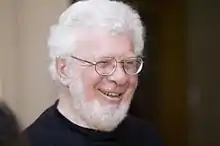Leonard Herzenberg | |
|---|---|
 | |
| Born | Leonard Arthur Herzenberg November 5, 1931 |
| Died | October 27, 2013 (aged 81) |
| Nationality | American |
| Alma mater | Brooklyn College California Institute of Technology |
| Known for | FACS[1] |
| Spouse | Leonore Herzenberg[2] |
| Children | Jana Herzen |
| Awards | Kyoto Prize (2006) |
| Scientific career | |
| Fields | Immunology, genetics |
| Institutions | Stanford University Pasteur Institute |
| Thesis | Studies on a Cytochrome Destroying System in Neurospora (1956) |
| Doctoral advisor | Herschel K. Mitchell[3] |
Leonard Arthur "Len" Herzenberg (November 5, 1931 – October 27, 2013) was an immunologist, geneticist and professor at Stanford University. His contributions to the development of cell biology made it possible to sort viable cells by their specific properties.[2][4][5][6][7][8]
Education
Herzenberg was born in New York City, U.S.A. He received his bachelor's degree in 1952 from Brooklyn College in biology and chemistry. In 1955, he received his Ph.D. from California Institute of Technology in biochemistry with a specialization in immunology for studies on cytochrome in Neurospora.[3]
Career
After school he was a postdoctoral fellow at the American Cancer Society, working in France at the Pasteur Institute. He returned to the United States in 1957 and worked for the National Institutes of Health as an officer in the Public Health Service department. He started working at Stanford in 1959. He eventually earned the title Professor of Genetics.[7]
In 1970 Herzenberg developed the fluorescence-activated cell sorter (FACS)[1][7] which revolutionized immunology and cancer biology, and is the basis for purification of adult stem cells.
During a sabbatical in the laboratory of Cesar Milstein between 1976 and 1977, Herzenberg coined the term hybridoma for hybrid cells that result from the fusion of B cells and myeloma cells.[9]
Personal life
Herzenberg and his wife, Leonore Herzenberg,[2] ran the Herzenberg Laboratory at Stanford together[10] until his death. Their daughter, Jana Herzen, is a singer-songwriter and the founder of Motéma Music. He died on October 27, 2013, aged 81.[6]
Awards and honours
Herzenberg received a range of honours and awards during his life including:
- 1998 American Association of Immunologists Lifetime Achievement Award[11]
- 2002 Edwin F. Ullman Award, American Association of Clinical Chemistry
- 2004 Special Novartis Prize for Immunology (the only winner of this award)
- 2005 Abbott Laboratories Award in Clinical and Diagnostic Immunology, American Society for Microbiology
- 2006 Kyoto award for his work in cell biology;
- 2007 Ceppellini Award, International Foundation for Research in Experimental Medicine, with his wife Lee Herzenberg for "their internationally recognized contributions to medicine"
- 2013 ABRF Annual Award for Outstanding Contributions to Biomolecular Technologies
References
- 1 2 Herzenberg, L. A.; Parks, D.; Sahaf, B.; Perez, O.; Roederer, M.; Herzenberg, L. A. (2002). "The history and future of the fluorescence activated cell sorter and flow cytometry: A view from Stanford". Clinical Chemistry. 48 (10): 1819–1827. doi:10.1093/clinchem/48.10.1819. PMID 12324512.
- 1 2 3 Herzenberg, Leonard A.; Herzenberg, Leonore A.; Roederer, M. (2013). "A Conversation with Leonard and Leonore Herzenberg". Annual Review of Physiology. 76: 130819115335001. doi:10.1146/annurev-physiol-021113-170355. PMID 23957332.
- 1 2 Herzenberg, Leonard (1956). Studies on a cytochrome destroying system in Neurospora (PhD thesis). California Institute of Technology.
- ↑ Roederer, M. (2013). "Leonard Herzenberg (1931–2013) Immunologist who pioneered cell-sorting technology". Nature. 504 (7478): 34. doi:10.1038/504034a. PMID 24305144.
- ↑ Leonard Herzenberg's publications indexed by the Scopus bibliographic database. (subscription required)
- 1 2 Roederer, Mario (October 28, 2013). "Len Herzenberg - 1931-2013". Purdue University Cytometry Laboratories. Retrieved October 29, 2013.
- 1 2 3 "The History of the Cell Sorter Interviews". Record Unit 9554. Smithsonian Institution Archives. Retrieved 9 March 2012.
- ↑ Kalte, Pam M.; Nemeh, Katherine H.; and Schusterbauer, Noah (2005) "Herzenberg, Leonard Arthur (1931-)" American Men & Women of Science: A biographical directory of today's leaders in physical, biological and related sciences (22nd ed.)Thomson Gale, Detroit;
- ↑ Milstein, César (1999-10-11). "The hybridoma revolution: an offshoot of basic research". BioEssays. 21 (11): 966–973. doi:10.1002/(SICI)1521-1878(199911)21:11<966::AID-BIES9>3.0.CO;2-Z. PMID 10517870.
- ↑ McCarthy, Pumtiwitt (2012). "The road well traveled together: A joint "Reflections" by Leonore and Leonard Herzenberg". ASBMB Today. Retrieved 26 August 2015.
- ↑ "Past Recipients". The American Association of Immunologists. Retrieved 19 September 2018.
External links
- "Leonard Arthur Herzenberg" Inamori Foundation Kyoto Award;
- Leonard Herzenberg's homepage at Stanford at the Wayback Machine (archived March 19, 2005);
- Pincock, Stephen (9 June 2006) "Herzenberg wins Kyoto Prize" The Scientist: Magazine of the Life Sciences 2006(June 9): ;
- "A Conversation with Leonard and Leonore Herzenberg"